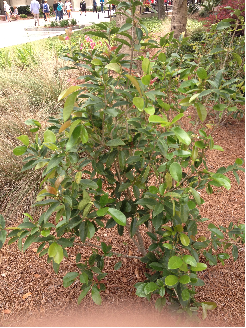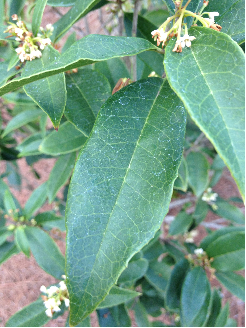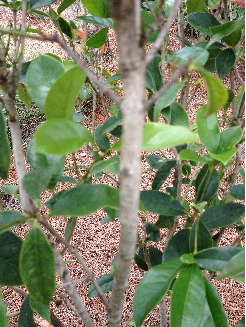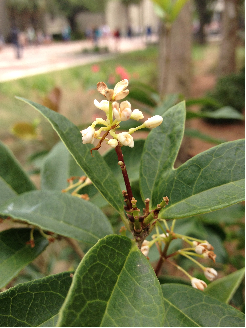Tea Olive
Osmanthus fragrans

(Photo by Hatel Patel)
View the Location on Campus
Taxonomy (1)
Classification: Angiosperm, dicot
Family: Oleaceae
Common name: Tea olive, fragrant olive, sweet olive
General Information (1,2)
Region of Origin: Asia
USDA Plants Hardiness Zones: 8-10
Growth Habit: Shrub
- Size: 20 feet tall
- Deciduous/Evergreen: Evergreen
- Flowering: Autumn, winter, early spring
Diagnostic Characteristics
Leaves (1,2)
- Arrangement: Opposite
- Simple/Compound: Simple
- Shape: Oblong, lanceolate, elliptic
- Other: Leathery

(Photo by Hatel Patel)
Stem/Bark (3)
- Color: Brown

(Photo by Hatel Patel)
Flower (1)
- Color: White
- Size: 1/4 inch

(Photo by Hatel Patel)
Fruit (3)
- Fruit type: Drupe
- Size: 3/8 inch
- Color: Black
Horticultural Information (1)
- Light: Full sun to partial shade
- Maintenance: Easy to care for
- Landscape Uses: Foundation plantings and accents
- Other: Very fragrant
Interesting Facts (1)
- Tea olive has fragrant flowers that smell a lot like a fringe tree.
- Tea olive is a traditional element in the southern garden landscape.
References
1) Scheper, Jack. (1996).Osmanthus fragrans. Retrieved from http://www.floridata.com/ref/o/osm_frag.cfm
2) Dirr,M.A.(1990). Manual of Woody Landscape Plants: Their Identification, Ornamental Characteristics, Culture, Propagation and Uses. Champaign,Illinois: Stipes Publishing Company.
3) Tea olive. Osmanthus fragrans. Retrieved from http://nassau.ifas.ufl.edu/horticulture/demogarden/printables/Tea%20Olive.pdf
Edited by Jessica Bartek
Department of Biology
-
Room 2035, 2nd Floor
Bailey Science Building -
Mailing Address
1500 N. Patterson St.
Valdosta, GA 31698 - Phone: 229.333.5759
- Fax: 229.245.6585
Monday - Thursday
8:00AM until 5:30PM
Friday
8:00AM until 3:00PM
Saturday - Sunday
Office Closed